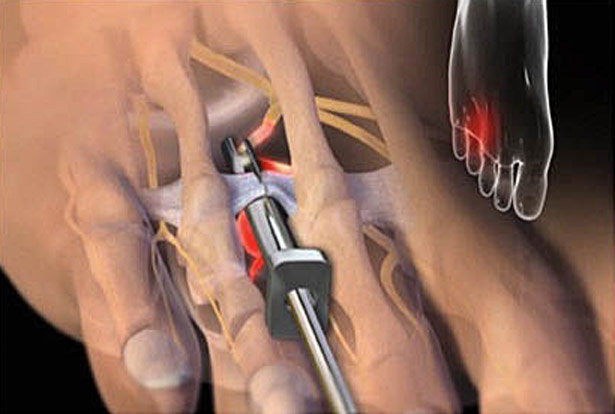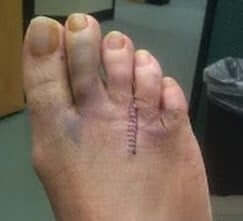Morton’s Neuroma Decompression Surgery is only recommended if Ultrasound Guided Ablations fail.
Should I have Morton’s neuroma surgery? (or why shouldn’t I have Morton’s neuroma surgery?)

In some patients Morton’s neuroma surgery is unavoidable because their Morton’s neuroma is resistant to any other means of treatment. However in the vast majority of cases surgery is avoidable. (We only consider surgery for Morton’s neuroma as a last option when all other non-surgical treatments have failed.)

This procedure is essentially the same as a traditional Morton’s neuroma surgical neurectomy with the one significant difference: the nerve (the Common Plantar Digital nerve) is not cut but the overlying tendon is cut (i.e. the nerve is “released” or “decompressed”).
The procedure can be performed endoscopically but when it done endoscopically there is no direct visualization of the neuroma or entrapment or removal of scar tissue. When performed openly, the Deep Transverse Intermetatarsal Ligament (DTML) (which is the ligament partially responsible for compressing/entrapping the nerve) is cut and any other tissues that are compressing the nerve are cut. Approximately 40% of the cases require some dissection of scar tissue that surrounds the nerve.
The Deep Transverse Metatarsal Ligament is a series of 4 short ligamentous bands that span between the ends of adjacent metatarsal bones and intersect with the plantar ligaments of the metatarsophalangeal (MTP) joint.
1. The main reason we advise against Morton’s neuroma Decompression surgery is becasue we have more effective and less invasive treatments available. We have other less invasive and more effective treatments. We can effectively treat Morton’s neuroma without any surgery, (in many cases more effectively than surgery) and the recovery time from our procedures is only a couple of days.
For more information on the non-surgical options we offer to treat Morton’s neuroma, CLICK HERE.
2. The other main reason we advise against decompression surgery is the risk or foot instability. Morton’s neuroma decompression surgery cuts the Deep Transverse Metatarsal Ligament which can result in post operative foot instability, with forefoot splaying and potential long term gait problems.
The plantar plates of the metatarsophalangeal joints together with the intervening deep transverse metatarsal ligaments form a continuous band of strong ligamentous structures across the forefoot creating a bar system that prevents undue splay of the forefoot. Cutting the DTML can destabilize this continuous band.
3. Risk of creating more scar tissue. Any surgical manipulation of the nerve creates scar tissue which can be very painful. Scar tissue is one of the main reasons of post Morton’s neuroma surgery pain and can be very difficult to treat. Why risk creating scar tissue when all this can be avoided with Ultrasound Guided Alblation Procedures?
See below for a more in depth discussion of why we advise AGAINST decompression surgery.
Morton’s neuroma decompression surgery is a potential option if Ultrasound Guided Ablations fail. In most cases Ultrasound Guided Ablations are effective in significantly decreasing pain and increasing function, but in the unlikely case that these fail Morton’s Neuroma Decompression Surgery is an option.
Morton’s Neuroma Decompression Surgery should definitely be chosen over Morton’s neuroma neurectomy surgery, which cuts the Common Plantar Digital nerve. Neurectomy surgery has a high rate of failure (up to 30% failure rate.) When neurectomy fails, the results is often a foot that is more painful than the original neuroma and more difficult to treat.
Morton's neuroma decompression surgery cuts the Deep Transverse Metatarsal Ligament (DTML) which can result in post operative foot instability, with forefoot splaying and potential long term gait problems.
The plantar plates of the metatarsophalangeal joints together with the intervening deep transverse metatarsal ligaments form a continuous band of strong ligamentous structures across the forefoot creating a bar system that prevents undue splay of the forefoot. Cutting the DTML can destabilize this continuous band.

We have other less invasive and more effective treatments.
We can effectively treat Morton’s neuroma without surgery, (in many cases more effectively than surgery) and the recovery time from our procedures is only a couple of days.
For more information on the non surgical options we offer to treat Morton’s neuroma, CLICK HERE.
Surgery for Morton’s neuroma is often associated with complications, most commonly post surgical pain. Any manipulation of the nerve, such as decompression surgery, which cuts the Deep Transverse Metatarsal Ligament risks creating scar tissue which is one of the main causes of post Morton's neuroma surgery pain. In many cases the post surgical foot pain may be as bad or worse than before surgery. Some studies have shown that up to 35% of patients who have neurectomy surgery end up with unacceptable levels of post surgical pain.
Post Morton’s neuroma surgery foot pain is much more difficult to treat than pre surgery Morton’s neuroma foot pain because the exact cause of your pain after Morton’s neuroma surgery can be difficult to determine. It can even be difficult to localize the exact position of your pain after surgery. For more information on pain after Morton’s neuroma surgery (“post neurectomy pain”), CLICK HERE.
The basic recovery time from Morton’s neuroma decompression surgery is frequently 3 or possibly 4 weeks, even if a top of the foot (“dorsal”) surgical approach is used and it can easily take 3-4 months to for the full effects of surgery. In other words, it can take 3-4 months to become fully mobile.
If another surgery is required, the success rate of a Morton’s neuroma redo surgery is considerably lower than the success rate of a first time Morton’s neuroma surgery. The redo Morton’s neuroma surgery is most commonly done through an incision in the bottom of the foot (the “plantar aspect” of the foot.) This approach results in an even longer and more painful recovery than a regular Morton’s neuroma surgery. It can take 4-6 months of painful recovery to fully recover from a redo Morton’s neuroma surgery.
There are always general surgical risks associated with any surgery and so surgery should always be avoided if possible.
However, in some cases when Morton’s neuroma is resistant to other treatments, surgery is the only option left and is unavoidable.


By providing us with your information you are consenting to the collection and use of your information in accordance with our Terms of Service and Privacy Policy.